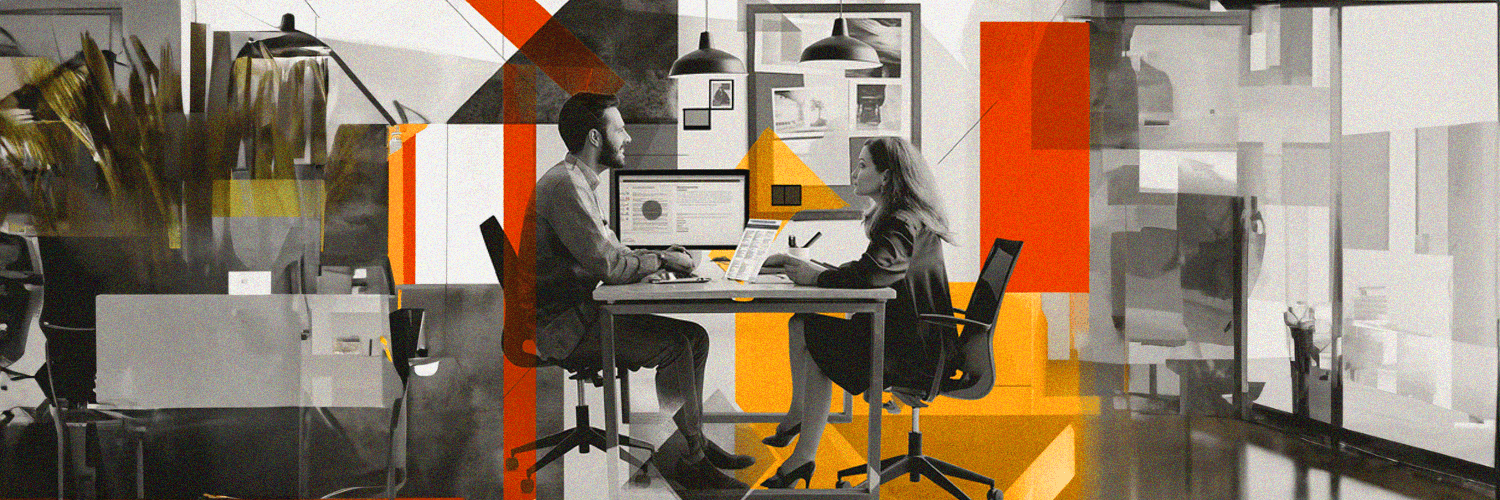Back in the 1940s, the open office emerged from the belief that to break down the social walls dividing people, you had to break down the real walls too. With the partitions removed, office design and seating arrangements had to be rethought to embrace flexibility. Eventually, this led to the birth of hot desking. In this article, we take a deeper look at its pros and cons and overview the most popular alternatives to this widely adopted yet harshly criticized office setup.
Hot or Not? The Problem With Hot Desking
Hot desking is a popular seating strategy where multiple employees use a single workstation during different time periods. It is based on the first come-first served principle, meaning that no prior reservations are required. Just come, sit, and work as long as you need.
Hot desking entails many wall-breaking ideas of the pioneers of the open office. It eliminates organizational hierarchy by applying the same seating rules to everyone, despite their title or status. It allows flexibility and promotes social interactions between employees. Above all, it is very cost and space-efficient. Having multiple employees sharing one workstation helps company owners cut down cost on expensive office leases.
However, hot desking has never been everyone’s cup of tea. The free-wheeling seating cannot offer much-needed predictability and ensure the most productive work environment for everyone. Some individuals prefer working around other people, others may need silence or... a dual monitor, which, because of hot-desking policies, they are not always able to access. Such situations create tension and might lead to conflicts.
Lastly, the global pandemic raised the question if hot desking is compliant with workplace health and safety. Although workplace technology offers ways to adapt it to the changing standards (for example, establishing a step like a check-in would help control capacity and track used desks for cleaning), many organizations started to look for alternative seating arrangements, at least for the time being.
Assigned Seating
With everyone having a permanent, designated workstation at the office, assigned seating caters to the need for structure and clarity. It is transparent (because everyone knows where to find their colleagues), and anchors employees to their personal space.
In contrast to other open office seating policies, the assigned setup is the least sensitive to the needs of employees. There’s not much space for mingling around, working in teams, or choosing the environment. In a way, assigned seating reminds the cubicles: although the boundaries are not visible, they still exist.
This limiting nature might be the reason why organizations that need to keep most of their staff on-site temporarily opt for assigned seating in their return-to-work strategies. Orderly in its essence, it does not require complex management and is relatively safe. In the transitional office, assigned seating helps establish bigger and more distanced personal workspaces, minimize social interactions, and keep up with hygiene standards.
Desk Hoteling
Much like in an actual hotel, desk hoteling setup requires booking the desired workstations upfront, on an as-needed basis, and check-in into them upon arrival to the office. In-advance planning is the only difference that separates hoteling from hot desking, but it solves the major problem associated with the latter. It eliminates frustration by managing expectations.
With desk hoteling, employees can choose desired workplaces way ahead of time, to make sure they are reserved for them. The consequences of spontaneity are the booker’s responsibility. By engaging everyone in a smooth planning process, desk hoteling combines the pros of assigned seating - order and organization - with the flexibility of hot desking.
Compared to other seating setups, desk hoteling is more challenging for employers, not employees. Some organizations hesitate to implement it because establishing the planning rules and rolling out the process might seem time-consuming. Truth is, only when it’s done manually. Because of that, workplace management solutions are indispensable from successful desk hoteling arrangements.
Activity-Based Working
Activity-based working is based on the idea that people perform a set of different tasks every day, therefore, they need a variety of environments to carry them out effectively. Starting the morning with a couple of video calls in a private office, joining the project team for brainstorming in a collaboration hub, moving to a shared desk after lunch, and ending the day pitching your ideas to co-workers in a meeting room - sounds like a perfect activity-based working scenario.
Spaces are essential in the activity-based working setup, but its main focus is people and their actions. It pushes employees to reflect on their to-dos and decide what is the most suitable environment to accomplish them. By taking into consideration different preferences, styles of working, and even relationships between colleagues, activity-based seating is programmed to yield increases in productivity and employee satisfaction.
Here, impeccable planning is a must. Without the ability to schedule, reserve, and check-in, the setup would lose its efficiency. Moreover, it could not function in the post-pandemic office. Organizations that want to keep (or adopt) activity-based work nowadays must make sure that their planning tools support important social distancing restrictions or capacity limitation between areas.
Hot Desking Vs Hoteling: Determining the Right Fit for Your Organizational Culture and Goals
Adopting either model isn’t merely about refurbishing your office layout—it reflects deeper organizational values and ambitions:
- For Collaborative Cultures: If fostering creativity through random employee interactions aligns with your goals, hot desking may be your alley.
- For Planning Aficionados: Desk hoteling suits teams valuing foresight in their schedules yet loathe being shackled to one spot.
- Space Efficiency: Both strategies maximize real estate usage but cater to varying degrees of control over workspace management.
Deciding requires introspection into what you value more—spontaneous connectivity or orderly flexibility—and how these correspond with your broader objectives.
Find the Perfect Hot Desk Booking Software with Yarooms
Choosing the right hot desk booking software is pivotal for businesses embracing flexible workplace strategies. It's about balancing functionality and user experience, ensuring management and employees find the process straightforward and beneficial. That's where Yarooms steps in, offering a comprehensive Workplace Experience Platform designed to streamline the transition to a more dynamic work environment.
Yarooms isn't just another booking system; it's an integrated solution that caters to the various needs of modern workplaces. Here are a few key features that set Yarooms apart:
- Desk Booking System: A core feature of Yarooms, this system simplifies desk reservation processes. Whether you're dealing with hot desking, desk hoteling, or even fixed seating arrangements for specific departments, it easily accommodates different space booking scenarios.
- Room Booking System: This indispensable tool ensures the smooth scheduling of meeting spaces without overlaps or conflicts. An intuitive interface allows users to book rooms for specific times, further supporting efficient office operations.
- Visitor Management System: Making guest experiences as streamlined as possible while maintaining workplace security has never been easier. This feature manages visitor records, enhancing your company's ability to make informed decisions based on visitor analytics.
These tools make transitioning into or optimizing a hybrid work model less daunting. The benefits extend beyond mere space management; they encapsulate an improved workplace experience for everyone involved.
Furthermore, Yarooms goes beyond basic functionalities by offering:
- Lobby Display Application: Enhance visibility within your workspace by showing the real-time booking status of all rooms through an engaging display lobby.
- Room Panel: A digital signage application that improves meeting room utilization and enhances the overall workplace experience by being intuitive and informative.
In essence, Yarooms offers more than just software; it provides a complete ecosystem to transform conventional offices into dynamic spaces conducive to productivity and collaboration. Check out how it works! ⬇️
Common Questions on Hot Desking vs Hoteling
What Does Hoteling Mean in an Office?
Office hoteling is essentially reserved seating taken digitally — imagine booking a room at a hotel but replacing ‘room’ with ‘desk.’ It allows employees to choose where they sit based on current project needs or personal preferences while providing managers better oversight of space utilization through reservation patterns tracking using dedicated software solutions.
What is an Example of Hoteling?
Jane Doe from Marketing needs quiet cubicle time before her campaign launch next week but prefers brainstorming sessions near graphic designers afterward. Through desk hotel development like Yarooms., she schedules her requisite spots hassle-free—demonstrating how tailored environments bolster productivity without infringing upon freedom merited by today’s mobile workforce era.









